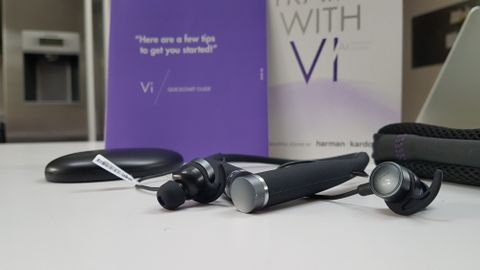Why you can trust TechRadar
Set up, sync and sharing
- Slick and simple set up
- Fast and reliable syncing
- Limited third-party sharing
The Vi experience out of the box is impressive, with some really intelligent touches, such as guiding notes on the packaging that lead you through setup and make the experience feel more human and supportive than with most products.
This is entirely deliberate, LifeBEAM wants users to develop a relationship with Vi rather than just see it as another piece of hardware, and it works.
You will need to download the Vi smartphone app and do the usual Bluetooth pairing and connection in order to go through the setup process.
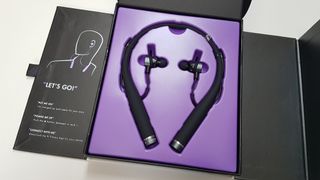
Once you power up the headset, the first thing Vi says to you is a joke. “First contaaaact with a human,” comes the ice breaker from your new coach.
It’s hard not to think of the first time Joaquin Phoenix’s character meets his AI in Her.
Vi then guides you through a few logistics like a microphone detection test and reminds you how important it is to use the right wing tips and gels for the perfect fit, as well as setting your specifics in the app.
At this point Vi also asks you to give yourself a nickname that she’ll use to address you while you run.
From within the app you can edit settings including warm up duration and what Vi calls Beacon updates, which are basically time and distance-based readouts for things like calories burned, average heart rate, speed, step rate, and pace.
You can also choose which metrics Vi gives you updates on when you use the "How am I doing?" voice command on a given run. These include heart rate, speed, pace, step rate and power.
And you can turn on the Effort Guide for in-run feedback on how hard to push, choose between metric and imperial and set Vi’s overall chattiness level, choosing from 'Lead the way' (she says what she wants when she wants), 'a little less', or 'short and sweet' (kind of leave me alone).
Some important customization options that we’d expect to see in an advanced coach are missing. For example, you can’t review the heart rate zones Vi has recorded or put in your own zones should you know them.
Syncing Vi with the smartphone app is always fast and reliable with no need to pair the device each time you train. Sadly however, while Vi will sync with Apple Health Kit and Google Fit, there are currently no options to automatically sync your run data to any apps such as Runkeeper or Garmin Connect, although since we published this review, Strava syncing is now added into the mix.
Likewise, there’s no way to automatically import any data, such as weight, from third parties. This puts Vi a way behind the likes of Polar, Garmin and TomTom.
Personalized coaching and sound quality
- Lacks a lot of essential running watch features
- Badly missing race-led goals and training schedules
- Human sounding voice and good sound quality
LifeBEAM knows if you’re going to spend a lot of time listening to a coach (virtual or real) it’s important you get along.
The company spent six months searching for the ‘perfect’ human voice to use for Vi’s persona and the result is an AI that feels much more human than other common AIs such as Siri and Alexa, and far more personable than any fitness-specific voice coaches we’ve ever used, such as Lumo Run and Moov Now.
Not only is Vi's voice great, but so is its sound quality, which isn't a huge surprise given that it's powered by Harmon Kardon. So whether you're listening to music or just to Vi's dulcet tones you won't be disappointed.
From the moment you fire her up, Vi’s phraseology, timing and the content of what she says goes a long way to making you feel like you’re dealing with an intuitive coach and not a robot blurting updates from a prescribed menu of responses. For example, Vi asks questions to guide you through the set up and calibrations on your first runs.

This ‘getting to know each other' phase is very impressive and offers a glimpse of how powerful this technology will be in the future. However, Vi has one big problem and it’s cultural.
At the risk of being accused of AI xenophobia, Vi’s strong American tones and turn of phrase didn’t really do it for our UK ears.
It wasn’t long before the in-run cheerleading started to grate. We’re all for enthusiasm but the over exuberance of some of the comments was a bit too much. You’ll need to like things with a little more fist pump and high five if you’re going to get along with Vi.
The language troubles weren’t a one-way street either. In our tests it was quickly clear that Vi simply doesn’t recognize a British accent, at least not ours. Given that most of Vi’s in-run features are controlled via voice, this is a problem.
During a run you can tap the touch sensor and say things likes “How am I doing?” or “Heart rate” for a read out of your current stats. You can also use voice to switch the Effort Guide on and off mid-run and say “Step to the beat” to launch Vi’s cadence coaching.
Unfortunately, practically the only voice command that worked was a simple "No" and even that was hit and miss.
But that’s not Vi’s only problem. Perhaps a bigger issue is that the coaching goals are far too limited. You can use the app to select up to six targets including Go Faster, Go Farther, Reduce Stress, Maintain Fitness and Improve Fitness, with one of these set as your primary goal.
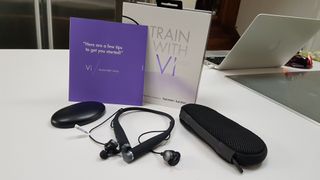
The problem here is that most serious runners don’t just run to ‘Go Faster’, they train with a target race and finish time in mind and Vi simply doesn’t offer you the chance to work towards a specific goal, for example, a 3:30 marathon or a Parkrun 5km best. And without this your training feels a bit rudderless.
After you’ve selected your goal, your first few runs with Vi are designed to let the AI learn your fitness levels, but this never feels like a fitness test and any recorded benchmarks aren’t displayed anywhere in the app.
It’s never very clear how Vi is assessing your runs and what data she’s using to support her training advice. It’s immediately hard, therefore, to get a sense of what improvement looks like in terms of any of the already very broad goals.
This gets worse when you realize that Vi doesn’t offer any training schedules or even recommend what kind of session you should do on any given day. You can’t even see how many sessions per week Vi advises in order to ‘Go Faster’ or ‘Go Further’.
It’s entirely up to you to decide when to train and to select your workout from the four modes of Free Run, Distance Run, Time Run or Cycle.
What is impressive is that once you start running Vi will look at things like heart rate, cadence, the weather and location and offer contextual advice, e.g. if your heart rate is up against your norm at a slow pace, she’ll maybe suggest taking this run easy as that can be a sign of fatigue or over-training.
But from a coaching perspective, without training plans and more pre and post-run advice, there’s too much missing for Vi to be considered a serious alternative to a proper coach.
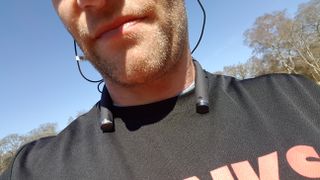
It’s a shame because with Vi there are features that offer a glimpse of what the future of running tech looks like. The Step to the Beat feature is fantastic. If Vi spots that your cadence is down against your average, she’ll ask if you want to do a quick burst of turnover training.
If you say "yes" Vi will play a metronome set to 180BPM giving you a beat to run to as you strive for improved cadence. You can also activate this yourself by saying “Run to the beat.”
Although, as we’ve mentioned, the voice commands rarely worked.
Vi also has an Effort Guide whereby she uses your past run data including pace and heart rate and compares that to your current mid-run performance to keep you informed about what zone you’re running in.
Instead of heart rate zones these are set as Recovery pace, Hustle and Beast mode, and Vi will tell you when you move between these zones.
Again, while the feedback is interesting we found there wasn’t enough real-time coaching here to be useful.
It's all well and good hearing that you've “Moved up to your hustle" – think threshold pace – but what you really need is Vi to tell you when it’s time to hustle, for how long and why doing this will help you achieve your goal. There’s too much respond and not enough lead.
If you’re a fan of indoor running there’s bad news here too. Vi doesn’t log distance via the accelerometer so when you’re on the treadmill you just get music and heart rate. There’s no way to add your distance to a workout post-run either.
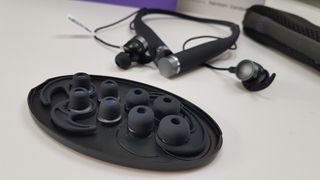
Heart rate and GPS tracking
- Reliable heart rate readings
- Uses your phone for GPS
Vi has two optical heart rate sensors, one in each earbud, and it’s important to get the right combination of gels and wing tips to ensure you get a good reading.
LifeBEAM started out making biometric monitoring tech for the aerospace industry, (AKA fighter pilots and astronauts) and so we expected good things from the heart rate tacking and we weren’t disappointed.
Once we’d nailed the perfect fit, we rarely lost heart rate tracking. Though if Vi spots heart rate tracking has dropped in and out during a run, she’ll suggest a change of tips and gels.
In terms of accuracy, we tested our resting heart rate against the wrist-based Polar M430 and a Polar H7 chest strap. We found that Vi tended to read 2-3 beats per minute higher than the Polar M430 and was largely identical to the chest strap.
On the run Vi performed well too versus the chest strap and the Polar M430. Vi was rarely more than 2-3 beats off the chest strap and the average heart rate readings were always within 1-2 beats per minute.
We have to point out here though that the way heart rate data is presented in a tiny graph in the Vi app makes it quite hard to analyze.
There’s no GPS chip on-board Vi, as this is tracked using your paired smartphone so you'll need to have that with you on your run for Vi to work. This also means that GPS accuracy depends entirely on how good your phone’s location-awareness is.
Smartphone app
- No web tools and the app lacks detail
- Slick design
There are no web tools, so we can move directly onto Vi’s partner smartphone app available for iOS and Android. The headline here is that the app really lets Vi down. The design is slick enough but there’s simply just not enough detail for it to compete with the likes of Garmin Connect or Polar Flow.
The home screen lets you select a run for that day from Free Run, Distance Run, Time Run or Cycling.
You can get a resting heart rate reading but it’d be great if this information was stored somewhere so you could track any change over time.
Current page: Specs, sound quality and fitness
Prev Page Introduction and design Next Page Battery life and verdict